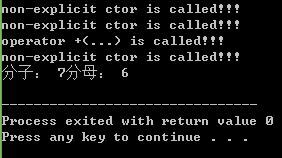课堂大纲
1.Conversion Function 转换函数
2.non-explicit-one-argument ctor 可隐式转换单一形参构造函数
3.explicit-one-argument ctor 非隐式转换单一形参构造函数
4.两种特殊的类
4.1. pointer-like class 智能指针
4.2. pointer_like class 迭代器
4.3. function-like classes: functor 仿函数
5.模板
5.1. 类模板
5.2. 函数模板
5.3. 成员模板
5.4. 模板特化
5.5.模板模板参数
6.关于C++标准库
7.reference 引用
注:由于本人对这部分内容的了解不深,所以无法写出很详细的心得,更多的是资料的汇总,引用是从网络上摘取出来的,请见谅。
正文
1.Conversion Function 转换函数
形式如:
#include
using namespace std;
class Fraction
{
public:
Fraction(int num, int den = 1) : m_numerator(num), m_denominator(den) { }
operator double( ) const
{
cout<<"operator double( ) is called!!!"< 运行结果:
转换函数的基本规则:
-转换函数只能是成员函数,无返回值,空参数。
-不能定义到void的转换,也不允许转换成数组或者函数类型。
-转换常定义为const形式,原因是它并不改变数据成员的值。
来源
在设计类的时候,如果觉得有必要写转换函数以及认为合理的,都是可以写成转换函数,
用于将该类型转换成其他类型的。
本类型->其他类型
2.non-explicit-one-argument ctor 可隐式转换单一形参构造函数
形式如:
#include
using namespace std;
class Fraction
{
public:
Fraction(int num, int den = 1) : m_numerator(num), m_denominator(den)
{
cout<<"non-explicit ctor is called!!!"<m_numerator+f.m_numerator, this->m_denominator+f.m_denominator);
}
int getNumerator() const {return m_numerator;}
int getDenominator() const {return m_denominator;}
private:
int m_numerator; //分子
int m_denominator; //分母
};
ostream& operator<<(ostream &os, const Fraction &f)//重载<<运算符
{
return os<<"分子: "< 运行结果:
那么如果转换函数和运算符+重载都在同一个类里面呢?按照上述的程序,会发生什么问题?
class Fraction
{
public:
...
Fraction operator + (const Fraction &f)
{
cout<<"operator +(...) is called!!!"<m_numerator+f.m_numerator, this->m_denominator+f.m_denominator);
}
operator double( ) const
{
cout<<"operator double( ) is called!!!"< 编译结果:
我个人认为是编译器不知道需要调用内置+运算还是用户自定义的+运算
缘由在于:
1.如果编译器利用类中的double()来将f转换为double型后,便可以用内置+号来作运算;
2.但编译器也可以将4转换成Fraction,然后在调用用户自定义的operator+。
但编译器不知道用户的真实目的是如何,所以便报错了。
有些时候编译器帮助我们完成的隐式转换会带来错误,为了解决这个问题,我们为此引入一个关键字↓
3.explicit-one-argument ctor 非隐式转换单一形参构造函数
class Fraction
{
public:
explicit Fraction(int num, int den = 1) : m_numerator(num), m_denominator(den) //请注意前面的关键字
{
cout<<"non-explicit ctor is called!!!"<m_numerator+f.m_numerator, this->m_denominator+f.m_denominator);
}
operator double( ) const
{
cout<<"operator double( ) is called!!!"< 编译结果是:
因为加了explicit关键字后,构造函数不会发生隐式转换,所以double转向Fraction时就会报错。
explicit 只对构造函数起作用,用来抑制隐式转换。
来源
4.两种特殊的类
4.1. pointer-like class 关于智能指针
template
class shared_ptr
{
public:
T& operator* ( ) const { return *px; }
T* operator->( ) const { return px; }
shared_ptr(T* p) : px(p) { }
private:
T* px;
long* pn;
};
使用举例:
struct Foo
{
......
void method(void) {......}
};
shared_ptr sp(new Foo);
Foo f(*sp); //*sp则调用shared_ptr类中的*重载运算符,返回了Foo类的一个指针所指的【对象】;
sp->method( ); //调用shared_ptr类中的->重载运算符,返回了一个Foo的指针。
//->比较特别,解引用之后还能继续传递下去。
网上摘取一段关于shared_ptr的使用例子
**shared_ptr
assert(sp.unique()); //现在shared_ptr是指针的唯一持有者
shared_ptr
assert(sp == sp2 && sp.use_count() == 2); //两个shared_ptr相等,指向同一个对象,引用计数为2
sp2 = 100; //使用解引用操作符修改被指对象
assert(sp == 100); //另一个shared_ptr也同时被修改
sp.reset(); //停止shared_ptr的使用
assert(!sp); //sp不再持有任何指针(空指针)
**
[来源](http://blog.csdn.net/sndaxdrs/article/details/6175701)
*注意:assert的作用是现计算表达式 expression ,如果其值为假(即为0),那么它先向stderr打印一条出错信息,然后通过调用 abort 来终止程序运行*
个人觉得,智能指针实际上就是传统普通指针的扩展,所以究其本质,其内部还是必须有一个普通指针,然后再拓展其功能。
####4.2. pointer_like class 迭代器
示例程序:
```C++
template
class __list_node
{
public:
void* prev;
void* next;
T data;
};
template
class __list_iterator
{
public:
...
typedef Ptr pointer;
typedef Ref reference;
reference operator * ( ) const { return (*node).data; }
pointer operator -> ( ) const { return &(operator*( )); }
...
};
list::iterator ite;
...
*ite; //获得一个Foo object;
ite->method( );//调用Foo::method( );
//相当于(*ite).method( );
//相当于(&(*ite))->method( );
迭代器本身就是一种指针,所以当用的时候,实际上是对该迭代器进行解引用,相当于读取它所指的对象的值,所以可以看到重载运算符函数里面是返回data的。
而当调用->的时候,可以分成operator*()被调用后,再被取值,为此相当于是先读取所指对象的值,然后再取地址,所以返回是一个指针。
另外,迭代器和智能指针不同之处是迭代器还要重载++或者--,进行指针移动操作。
4.3. function-like classes: functor 仿函数
被派出差,回来更~



